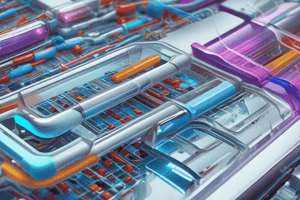Podcast
Questions and Answers
In paper-based microfluidics, detection reagents are pre-deposited onto the paper areas before users introduce the samples for testing.
In paper-based microfluidics, detection reagents are pre-deposited onto the paper areas before users introduce the samples for testing.
False (B)
A wax-printed 384-zone paper plate can be used after application of various dyes in microfluidic systems.
A wax-printed 384-zone paper plate can be used after application of various dyes in microfluidic systems.
True (A)
Integration of indication reagents into the detection zones of devices is a step in creating complete devices in microfluidics.
Integration of indication reagents into the detection zones of devices is a step in creating complete devices in microfluidics.
True (A)
Helen Murray Free was involved in the development of paper-based microfluidic systems in 1956.
Helen Murray Free was involved in the development of paper-based microfluidic systems in 1956.
Lateral Flow Strips are commonly used in Microfluidic Paper-based Analytical Devices (µPADs).
Lateral Flow Strips are commonly used in Microfluidic Paper-based Analytical Devices (µPADs).
The hydrophobic properties of paper play a significant role in the function of Microfluidic Paper-based Analytical Devices (µPADs).
The hydrophobic properties of paper play a significant role in the function of Microfluidic Paper-based Analytical Devices (µPADs).
Lateral flow strips have high sample volumes for effective sample consumption.
Lateral flow strips have high sample volumes for effective sample consumption.
Hydrophilic properties of paper are a disadvantage for paper-based microfluidics.
Hydrophilic properties of paper are a disadvantage for paper-based microfluidics.
Paper parameters such as porosity and thickness do not impact the performance of microfluidic paper-based analytical devices.
Paper parameters such as porosity and thickness do not impact the performance of microfluidic paper-based analytical devices.
Cellulosic materials are not commonly used in the fabrication of paper-based microfluidics.
Cellulosic materials are not commonly used in the fabrication of paper-based microfluidics.
Paper-based microfluidic devices are not suitable for use in developing countries due to high cost.
Paper-based microfluidic devices are not suitable for use in developing countries due to high cost.
Commercialized cheap dipsticks are not useful for diagnostics in developing countries.
Commercialized cheap dipsticks are not useful for diagnostics in developing countries.
Paper-based microfluidic devices are commonly used for glucose monitoring.
Paper-based microfluidic devices are commonly used for glucose monitoring.
The hematocrit portion of blood cells represents 80% of the blood volume.
The hematocrit portion of blood cells represents 80% of the blood volume.
Graphite and gold inks are commonly used for screen printing electrodes on paper-based test strips.
Graphite and gold inks are commonly used for screen printing electrodes on paper-based test strips.
Lateral flow strips rely on the hydrophobic properties of paper to function effectively.
Lateral flow strips rely on the hydrophobic properties of paper to function effectively.
Cellulosic materials are a common component in microfluidic paper-based analytical devices.
Cellulosic materials are a common component in microfluidic paper-based analytical devices.
Glucose monitoring can be done using an electrochemical detection method at electrodes.
Glucose monitoring can be done using an electrochemical detection method at electrodes.
Microfluidic systems are not applicable for paper-based devices due to their complexity.
Microfluidic systems are not applicable for paper-based devices due to their complexity.
Flashcards
Are reagents pre-deposited in paper-based microfluidics?
Are reagents pre-deposited in paper-based microfluidics?
False. Detection reagents are typically applied when the user introduces the sample.
Can wax-printed paper plates be used with dyes?
Can wax-printed paper plates be used with dyes?
True. Wax-printed paper plates can handle various dyes in microfluidic systems.
Is integrating reagents important?
Is integrating reagents important?
True. Incorporating reagents is essential for complete microfluidic devices.
Was Helen Murray Free involved in paper-based microfluidics in 1956?
Was Helen Murray Free involved in paper-based microfluidics in 1956?
Signup and view all the flashcards
Are lateral flow strips used in µPADs?
Are lateral flow strips used in µPADs?
Signup and view all the flashcards
Are hydrophobic properties important in µPADs?
Are hydrophobic properties important in µPADs?
Signup and view all the flashcards
Do lateral flow strips need high sample volumes?
Do lateral flow strips need high sample volumes?
Signup and view all the flashcards
Are hydrophilic properties a disadvantage?
Are hydrophilic properties a disadvantage?
Signup and view all the flashcards
Do paper parameters impact µPAD performance?
Do paper parameters impact µPAD performance?
Signup and view all the flashcards
Are cellulosic materials used in paper microfluidics?
Are cellulosic materials used in paper microfluidics?
Signup and view all the flashcards
Are paper devices unsuitable for developing countries?
Are paper devices unsuitable for developing countries?
Signup and view all the flashcards
Are cheap dipsticks useless for diagnostics?
Are cheap dipsticks useless for diagnostics?
Signup and view all the flashcards
Are paper devices used for glucose monitoring?
Are paper devices used for glucose monitoring?
Signup and view all the flashcards
Does hematocrit represent 80% of blood volume?
Does hematocrit represent 80% of blood volume?
Signup and view all the flashcards
Are graphite and gold inks used for electrodes?
Are graphite and gold inks used for electrodes?
Signup and view all the flashcards
Do lateral flow strips rely on hydrophobic paper?
Do lateral flow strips rely on hydrophobic paper?
Signup and view all the flashcards
Are cellulosic materials a common component?
Are cellulosic materials a common component?
Signup and view all the flashcards
Can electrochemical methods monitor glucose?
Can electrochemical methods monitor glucose?
Signup and view all the flashcards
Are Microfluidic systems applicable for paper-based devices?
Are Microfluidic systems applicable for paper-based devices?
Signup and view all the flashcards




